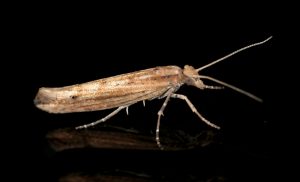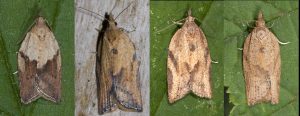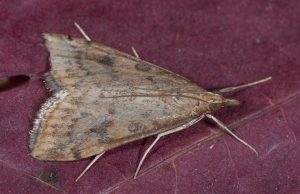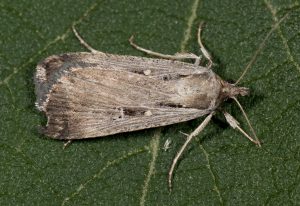December is generally to be a poor month for moths, and many moth enthusiasts put their traps away until the Spring. But there are still moths about especially if the weather is relatively mild (warmer than 5˚C at night), and many are under-recorded. The most abundant is the aptly named winter moth (Operophtera brumata). When driving you can often see this moth fluttering in the car’s headlights. Every moth seen flying is likely to be a male winter moth; female winter moths are virtually wingless and cannot fly; they just sit around emitting pheromones (the moth version of attractive perfume) to attract in the males. A female will lay about hundred eggs on almost any type of tree, which hatch in the Spring when the leaves are beginning to open. Heavy infestations of their looper caterpillars can cause serious damage to the foliage of trees and garden shrubs, but in early spring they are one of the main sources of food for tits to feed their newly hatched nestlings. In The Bourne we are at the southern limit of the very similar northern winter moth (Operophtera fagata), which is slightly larger and less common; it is also more choosy about its food plant and its caterpillars are confined to birch and apple.

Another moth that can be very abundant in December is the aptly named December moth Poecilocampa populi. These medium sized moths that have a charcoal background colour marked with creamy white lines and dots, particularly on the face. The adults do not feed, and so are not attracted by sugaring but they do come to lights. They lay their black eggs on the bare twigs of a variety of trees including oaks, birches, blackthorn and sallows. The slightly hairy caterpillars are black and decorated with white dots and hatch in the Spring as the leaf buds begin to open.

A winter moth that can be brightly coloured is the mottled umber (Erannis defoliaria). Its coloration is variable and, like the peppered moth, dark melanic forms turn up in industrialised regions. This is another species in which the female is flightless – it is a mystery to me as to how these moths have become so broadly dispersed. The females are like black and white spiders and may be found on the trunks of trees in woodland at night. The males can occasionally be seen at night flying about 2m above the ground beneath oak trees. The moth is a geometrid and so its caterpillars are loopers. In summer they are one of the species that can be found suspended by threads from oaks trees. They drop to the ground and pupate in the soil, and hatch as winter approaches.

Many of these winter moths an survive really icy conditions because they have an antifreeze in their blood. They are able to fly even on frosty nights, after spending some time fluttering their wings to warm up their muscles, rather like athletes before they run a race.
There are relatively few species of micromoth that overwinter as adults during the winter and can become active when the weather is mild. One of the most characteristic of these is the common plume moth (Emmelina monodactyla). With its thin wings, when flying it looks like a rather large mosquito, and when it settles it rolls its wings so that it is far from obvious that they are divide into lobes. Its caterpillars feed on bindweed so it is a very common species.

A native micromoth species that occurs mainly in the winter months is Ypsolopha ustella. The majority of micromoths do not have common names, but recently the species has been given the epithet, variable smudge – I prefer to use the proper scientific name even if it is a bit of a mouthful. Its caterpillars feed on oak. These small moths (about 11mm long) are also quite variable in their coloration.

Even more variable is a moth that can occur at any time of year and is the light brown apple moth (Epiphyas postvittana). This little moth is one of commonest micromoths around Farnham. Despite being so common, it is an invasive alien and is one of the species that gives moths a bad name. First recorded in Cornwall in 1936, it is thought to have come from Australia (there was a cricket tour by MCC to Australia that year, and one slightly tongue-in-cheek suggestion is that it was imported in one the cricket bags – so thank you Don Bradman). Since then it has spread from Landsend to John O’Groats. It can now be found at almost any time of year, but peaks in abundance in June and July and again in August and September, a result of it producing at least two generations each year. Its caterpillars will feed on almost any plant, they have been recorded as feeding on 123 plant species. However, it prefers to feed on apple, causing leaf curl and blemishes on the fruit, which renders the apples unacceptable for sale in supermarkets! It has also been accidentally introduced into America, where it was first recorded in California in 2007. Despite the deployment of 53,000 pheromone trap which caught 246,000 males its invasion could not be checked. It has been declared a noxious insect in the USA and Canada, as it costs the fruit growing industry over $100 million a year. Fortunately, here in Britain it is not such a nuisance. However, one wonders if the spraying with insecticides to control this and other insect pests is contributing to the sharp declines we are witnessing in our biodiversity. Commercial trees tend to get sprayed with insecticide, since affected apple tree produce distorted fruit which is unacceptable for super-markets.So how do you recognise it? It is quite small – males are 6-10mm long and females 7-13mm. Confusingly its colour patterns are highly variable; basically, it is dark brown with paler markings. Some specimens are pale at the front and dark at the back, but others are longitudinally streaked, but the general shape of the wings is characteristic.

There is always an element of chance when moth trapping. If there have been strong southerly winds, there is always the chance that migrant species originating from Southern Europe or from further afield may turn up. One of the regular migrants, which may arrive at almost any time of the year, but also turns up in midwinter is the rusty-dot pearl (Udea ferrugalis).

I have caught one great rarity in winter; on 18th December 2015, I decided to trap and caught just five moths, each one a different species. Four of them were typical winter moths. The fifth specimen was new to me and this was not surprising as it was the first ever record in Surrey of this African species, a levant blackneck (Tathorhynchus exsiccata). Southerly winds had carried a great plume of Saharan dust to Britain and with it came my levant blackneck.

This is typical of moth trapping – most times the catch is predicable, but on rare occasions a rare an interesting species turns up. So each time I examine a night’s catch, I get a frisson of excitement, something totally unexpected may turn up even in the depths of winter.
Martin Angel
